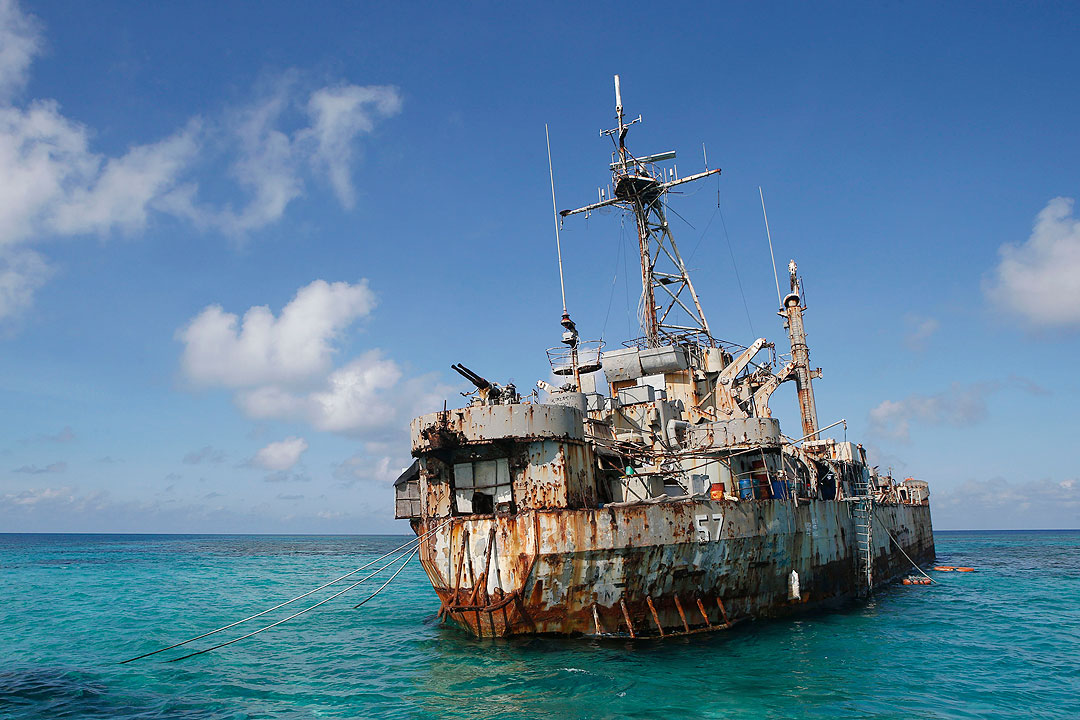Philippines told to boost war games aside from conducting joint patrols

By Kyle Aristophere T. Atienza, Reporter
THE PHILIPPINES should boost war games with other countries aside from holding joint resupply missions in the South China Sea, according to a geopolitical analyst.
“A joint resupply mission with another country would require detailed joint planning with that other country, and then joint war gaming to see what possible reactions could be anticipated,” Raymond Powell, the South China Sea lead at the Gordian Knot Center for National Security Innovation, said in an X message at the weekend.
Philippine military chief Romeo S. Brawner, Jr. last week said they were considering joint resupply missions with other countries due to persistent blocking by Chinese ships of smaller Philippine vessels that try to deliver food and other supplies to a grounded ship at Second Thomas Shoal.
The military might also use a Philippine Navy vessel for the resupply missions because they are more equipped for such operations, he said.
The Philippines last week filed a diplomatic protest against China and summoned its envoy in Manila after Chinese ships on Oct. 22 collided with Philippine vessels on a resupply mission at the shoal.
Mr. Marcos met with security agencies to “discuss the latest violation by China in the West Philippine Sea,” the presidential palace said in a statement, referring to areas of the South China Sea within the country’s exclusive economic zone.
“China has spent years blockading the BRP Sierra Madre with the strategy of forcing the Philippines to abandon it once it is no longer inhabitable,” Mr. Powell said. “It will not give up that strategy easily.”
The Philippines deliberately grounded the World War II-era ship in 1999 to assert its sovereignty.
A joint resupply mission must be “comprehensively war-gamed,” Mr. Powell said, adding that the Philippines and its allies should consider all the possible Chinese responses since it’s unlikely that China would simply sit back and watch it happen. “There is a saying in the military that ‘No plan survives first contact with the enemy.’”
Philippine Defense Secretary Gilberto C. Teodoro, Jr. has described the Oct. 22 collisions as a “serious escalation” of Chinese aggression within Manila’s 200-nautical mile exclusive economic zone in the South China Sea.
Unaizah Mae 2, one of the two boats contracted by the Armed Forces of the Philippines for the resupply mission, was damaged after it collided with a much larger China Coast Guard vessel.
While escorting the Unaizah Mae 2, the Philippine Coast Guard’s (PCG) BRP Cabra also collided with a Chinese maritime militia ship, which was blocking it from accompanying the resupply boat.
Five Chinese Coast Guard ships “participated in the shadowing, dangerous maneuvers and blocking” of the mission, while eight Chinese maritime militia vessels helped block the resupply contingent, Philippine Coast Guard spokesman Jay Tristan Tarriela on Oct. 23.
“What should be messaged to Beijing, formally and informally?” he asked. “Should Beijing be warned of consequences if it interferes, and what consequences could those include?”
In August, Pentagon Press Secretary Pat Ryder said the United States was ready to help the Philippines in its resupply missions.
‘MESSAGING’
“If the US is involved, how should the messaging refer to the Mutual Defense Treaty?” Mr. Powell asked. “Should the mission be conducted with navy or coast guard assets, or both?”
“How close should the foreign navy vessels come to BRP Sierra Madre, and will they draw in a heavier People’s Republic of China navy presence?”
The Philippines and the US have a 1950s Mutual Defense Treaty that compels both to defend each other in case of an armed attack.
In May, the two countries through their respective Defense chiefs agreed on new guidelines for the treaty, including a provision that the treaty could be invoked if either of them is attacked in the South China Sea.
The guidelines cited modern forms of warfare including “grey zone tactics,” which China has allegedly been using to assert its claims. But the guidelines did not mention Beijing.
“Recognizing that threats may arise in several domains – including land, sea, air, space, and cyberspace – and take the form of asymmetric, hybrid, and irregular warfare and grey-zone tactics, the guidelines chart a way forward to build interoperability in both conventional and non-conventional domains,” the Pentagon said in a statement at that time.
The Oct. 22 incident has gained the attention of the international community, with US President Joseph R. Biden warning that the US would not hesitate to intervene if Philippine vessels are attacked in the South China Sea.
“I want to be very clear: The United States’ defense commitment to the Philippines is ironclad,” he said in a joint press briefing with Australian Prime Minister Anthony Albanese in Washington DC, based on a transcript from the White House.
Mr. Biden said Chinese vessels had “acted dangerously and unlawfully” as the Philippines conducted a resupply mission “within their own exclusive economic zone in the South China Sea.”
“Any attack on the Filipino aircraft, vessels or armed forces will invoke… our Mutual Defense Treaty with the Philippines.”
The US donated BRP Sierra Madre to the Philippines in 1997 and was grounded at Second Thomas Shoal after China’s seizure of Mischief Reef.
The rusting vessel, which the Philippine government plans to restore, has been a source of tension this year between Manila and Beijing, which fired water cannons at Philippine vessels that were on a resupply mission on Aug. 5.
In April, the Philippines and the US held their largest-ever military drills, doing a live-fire exercise on a sunken ship in the South China Sea.
The annual shoulder-to-shoulder exercises were participated in by more than 17,000 soldiers.
Mr. Marcos in February gave the US access to four more military bases on top of the five existing sites under their 2014 Enhanced Defense Cooperation Agreement.



